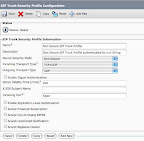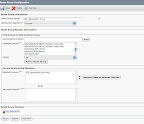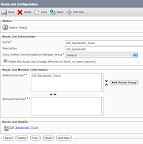One of the systems I manage is an 875 Extension Cisco Unified Call Manager(UCM). At the moment the system uses SCAN trunks for long distance calling. These SCAN Trunks are provided by the state of Washington and interconnect via a four port FXO card. Callers use a PIN to make long distance calls. This is some seriously old school technology and as such has sound quality to match.
So, armed with a four port SIP trunk account from Bandwidth.com, I set forth to make a SIP trunk from the UCM to Bandwidth.com. Long story short… it does not look like I can. I can set things up that should work, but don’t. There is an active TAC open with Cisco and when(if) we make it work then I’ll be back in a new blog entry.
Instead, we have “Cisco Unified CM 6.1 to Asterisk as SIP Proxy for Long Distance service.”
What is difficult to impossible with UCM is trivial in Asterisk w/FreePBX.
For Bandwidth.com I made a new SIP Trunk with the name of “freepbx” and here are the PEER Details:
username=myusername
type=peer
sendrpid=yes
secret=mypassword
qualify=yes
insecure=very
host=trunk.freepbx.com
fromdomain=trunk.freepbx.com
context=from-trunk
The Register name was formated like this:
myusername:[email protected]/360746XXXX
For the UCM, I made a SIP Trunk named “ucm” and here are the PEER Details:
type=peer
context=from-callmanager
host=10.XXX.XXX.XXX
disallow=all
allow=ulaw&alaw
nat=no
canreinvite=no
qualify=yes
and in extensions_custom.conf, courtesy of Philippe, I added ( to have these calls bypass most of the dialplan logic )
[from-callmanager]
include => from-internal
exten => _1NXXNXXXXXX,1,Dial(${OUT_12}/${EXTEN});
exten => _1NXXNXXXXXX,n,hangup
NOTE: the the “OUT_12” reflects the “freepbx” trunk and the last thing to do is allow anonymous SIP as the calls are routed w/o authentication from the UCM ( for now.)
| From CallManagerToSIP |
 |
| From CallManagerToSIP |
 |
| From CallManagerToSIP |
Then we create the SIP Trunk, noting that the “Calling Search Space” in this case is “Reserved Incoming Calls” which basically does not allow inbound calls to go anywhere:
 |
| From CallManagerToSIP |
The last three items to set up are the “Route Group, Route List and Route Pattern.”
Here is the Route Group:
 |
| From CallManagerToSIP |
Here is the Route List:
 |
| From CallManagerToSIP |
And since we need a way to direct calls out this SIP Trunk to make long distance calls, here is the Route Pattern so users dial “891NXXXXXXXXX” to dial out:

Bare in mind, I only want calls going out this trunk ( not in) so if you wanted bi directional calls… You would adjust the “Calling Search Space” in the trunk to allow it.
Otherwise, that is the setup that is live for now. Once an Authenticated SIP Trunk can be sorted out on the UCM, I plan to go directly to Bandwidth.com and skip the proxy.
